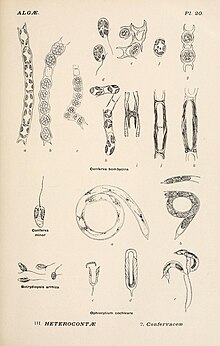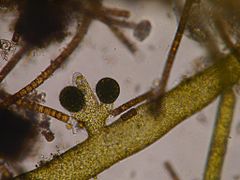Yellow-green algae
| Yellow-green algae | |
|---|---|

| |
| Examples of xanthophytes (repair the unequal flagella in the cells) | |
| Scientific classification | |
| Domain: | Eukaryota |
| Clade: | Diaphoretickes |
| Clade: | SAR |
| Clade: | Stramenopiles |
| Phylum: | Gyrista |
| Subphylum: | Ochrophytina |
| Superclass: | Fucistia |
| Class: | Xanthophyceae Allorge, 1930,[1]emend.Fritsch,1935[2] |
| Synonyms | |
Yellow-green algaeor theXanthophyceae(xanthophytes) are an important group ofheterokontalgae. Most live in fresh water, but some are found in marine and soil habitats. They vary from single-celledflagellatesto simple colonial and filamentous forms. Xanthophytechloroplastscontain thephotosyntheticpigmentschlorophylla,chlorophyllc,β-carotene,and thecarotenoiddiadinoxanthin.[7]Unlike otherStramenopiles(heterokonts), their chloroplasts do not containfucoxanthin,which accounts for their lighter colour. Their storagepolysaccharideischrysolaminarin.[7]Xanthophyte cell walls are produced ofcelluloseandhemicellulose.[7]They appear to be the closest relatives of thebrown algae.
Classifications
[edit]The species now placed in the Xanthophyceae were formerly included in theChlorophyceae.[8]In 1899, Lüther created the group Heterokontae for green algae with unequal flagella. Pascher (1914) included the Heterokontae in theChrysophyta.In 1930, Allorge renamed the group as Xanthophyceae.
The monadoid (unicellular flagellates) and also sometimes the amoeboid species have been included by some authors in theProtozoaorProtista,[9][10]as order Heterochloridina (e.g., Doflein and Reichenow, 1927-1929[11]), as class Xanthomonadina, with orders Heterochloridea and Rhizochloridea (e.g., Deflandre, 1956[12]), as order Heterochlorida (e.g., Hall, 1953,[13]Honigberg et al., 1964[14]), as order Heteromonadida (e.g., Leedale, 1983[15]), or as subclass Heterochloridia (e.g., Puytorac et al., 1987[16]). These groups are calledambiregnal protists,as names for these have been published under either or both of the ICZN and the ICN.
AlgaeBase (2020)
[edit]Xanthophyceae have been divided into the following five orders in some classification systems:[17]
- Dictyosphaeriopsis
- Groenlandiella
- Halosphaeropsis
- Pelagocystis
- Polyedrium
- Pseudopleurochloris
- Raphidosphaera
- Sphaerochloris
- Tiresias
- OrderBotrydialesSchaffner 1922
- FamilyBotrydiaceaeRabenhorst 1863e.g.Botrydium
- OrderMischococcalesFritsch 1927
- FamilyBotrydiopsidaceaeHibberd 1980e.g.Botrydiopsis
- FamilyBotryochloridaceaePascher 1938e.g.Ilsteria
- FamilyCentritractaceaePascher 1937e.g.Centritractus
- FamilyCharaciopsidaceaePascher 1938e.g.Characiopsis,Chlorothecium
- FamilyChloropediaceaePascher 1931e.g.Chloropedia
- FamilyGloeobotrydaceaePascher 1937e.g.Gloeobotrys
- FamilyGloeopodiaceaePascher 1938e.g.Gloeopodium
- FamilyMischococcaceaePascher 1912e.g.Mischococcus
- FamilyOphiocytiaceaeLemmermann 1899e.g.Ophiocytium
- FamilyPleurochloridaceaePascher 1937e.g.Meringosphaera,Pleurochloris
- FamilyTrypanochloridaceaeGeitler ex Pascher 1938e.g.Trypanochloris
- OrderRhizochloridalesPascher 1925
- FamilyMyxochloridaceaePascher 1937e.g.Myxochloris
- FamilyRhizochloridaceaePascher 1925e.g.Rhizochloris
- FamilyStipitococcaceaePascher ex Smith 1933e.g.Stipitococcus
- OrderTribonematalesPascher 1939
- FamilyHeterodendraceaePascher 1939e.g.Heterodendron
- FamilyHeteropediaceaeHibberd 1982e.g.Heterococcus,Heteropedia
- FamilyNeonemataceaeEttl 1977e.g.Neonema
- FamilyTribonemataceaeWest 1904e.g.Tribonema
- FamilyXanthonemataceaeSilva 1980e.g.Xanthonema
- OrderVaucherialesNägeli ex Bohlin 1901[18]
- FamilyVaucheriaceae(Gray) Dumortier 1822e.g.Vaucheria
Lüther (1899)
[edit]Classification according to Lüther (1899):[19][20]
- Class Heterokontae
- Order Chloromonadales
- Order Confervales
Pascher (1912)
[edit]Classification according to Pascher (1912):[21]
- Heterokontae
- Heterochloridales
- Heterocapsales
- Heterococcales
- Heterotrichales
- Heterosiphonales
Fritsch (1935)
[edit]Fritsch (1935) recognizes the following orders in the class Xanthophyceae:[22]
- Order Heterochloridales
- Family Heterochloridaceae (e.g.,Heterochloris)
- Family Heterocapsaceae (e.g.,Chlorogloea)
- Family Mischococcaceae (e.g.,Mischococcus)
- Family Heterorhizidaceae (e.g.,Rhizolekane)
- Order Heterococcales
- Family Halosphaeraceae (e.g.,Halosphaera)
- Family Myxochloridaceae (e.g.,Myxochloris)
- Family Chlorobotrydaceae(e.g.,Chlorobotrys)
- Family Chlorotheciaceae (e.g.,Chlorothecium)
- Family Ophiocytiaceae (e.g.,Ophiocytium)
- Order Heterotrichales
- Family Tribonemataceae (e.g.,Tribonema)
- Family Heterocloniaceae (e.g.,Heterodendron[?])
- Order Heterosiphonales
- Family Botrydiaceae (e.g.,Botrydium)
Smith (1938)
[edit]In the classification ofSmith (1938),there are six orders in the class Xanthophyceae, placed in the division Chrysophyta:
- OrderHeterochloridales(e.g.,Chlorochromonas)
- OrderRhizochloridales(e.g.,Chlorarachnion)
- OrderHeterocapsales(e.g.,Chlorosaccus)
- OrderHeterotrichales(e.g.,Tribonema)
- OrderHeterococcales(e.g.,Botrydiopsis)
- OrderHeterosiphonales(e.g.,Botrydium)
Pascher (1939)
[edit]Pascher (1939) recognizes 6 classes in Heterokontae:[23]
- Class Heterochloridineae
- Class Rhizochloridineae
- Class Hetcrocapsineae
- Class Heterococcincae
- Class Hetcrotrichineae
- Class Heterosiphonineae
Copeland (1956)
[edit]Copeland (1956) treated the group as order Vaucheriacea:[24]
- KingdomProtoctista
- PhylumPhaeophyta
- ClassHeterokonta
- Order Vaucheriacea
- Family Chlorosaccacea
- Family Mischococcacea
- Family Chlorotheciacea
- Family Botryococcacea
- Family Stipitococcacea
- Family Chloramoebacea
- Family Tribonematacea
- Family Phyllosiphonacea
- Order Vaucheriacea
- ClassHeterokonta
- PhylumPhaeophyta
Ettl (1978), van den Hoek et al. (1995)
[edit]In a classification presented byvan den Hoek, Mann and Jahns (1995),based on thelevel of organizationof thethallus,there are seven orders:
- OrderChloramoebales(e.g.,Chloromeson) - flagellate organisms
- OrderRhizochloridales(e.g.,Rhizochloris,Myxochloris) - ameboid organisms
- OrderHeterogloeales(e.g.,Gloeochloris) - palmelloid (tetrasporal) organisms
- OrderMischococcales(e.g.,Chloridella,Botrydiopsis,Characiopsis,Ophiocytium) - coccoid organisms
- OrderTribonematales(e.g.,Tribonema,Heterococcus,Heterodendron) - filamentous organization
- OrderBotrydiales(e.g.,Botrydium) - siphonous organization; sexual reproductionisogamousor anisogamous
- OrderVaucheriales(e.g.,Vaucheria) - siphonous organization; sexual reproduction oogamous
These are the same orders of the classification of Ettl (1978),[25]an updated version of the classic work by Pascher (1939).Ultrastructuralandmolecular studiesshows that the Mischococcales might be paraphyletic, and the Tribonematales and Botrydiales polyphyletic,[26]and suggests two orders at most be used until the relationships within the division are sorted.[27]
Maistro et al. (2009)
[edit]Informal groups, according to Maistro et al. (2009):[28]
- Botrydiopsalean clade
- Chlorellidialean clade
- Tribonematalean clade
- Vaucherialean clade
Unicellular flagellates, amoeboid and palmelloid taxa were not included in this study.
Adl et al. (2005, 2012)
[edit]According to Adl et al. (2005, 2012):[27][29]
- Tribonematales (generaBotrydium, Bumilleriopsis, Characiopsis, Chloromeson, Heterococcus, Ophiocytium, Sphaerosorus, Tribonema, Xanthonema)
- Vaucheriales (genusVaucheria)
-
Stipitococcus capense(Rhizochloridales)
-
Ophiocytium arbusculum(Mischococcales), formerlySciadium arbuscula
-
Vaucheriasp.
-
Other genera
-
Botrydium granulatum(Botrydiales)
-
Vaucheriasp. (Vaucheriales), thallus
-
Vaucheriasp., sexual reproductive organs
See also
[edit]References
[edit]- ^Allorge, P (1930). "Heterocontées ou Xanthophycées?".Rev. Alg.5:230.
- ^Fritsch, F.E. (1935)The Structure and Reproduction of the Algae. Volume I. Introduction, Chlorophyceae, Xanthophyceae, Chrysophyceae, Bacillariophyceae, Cryptophyceae, Dinophyceae, Chloromonadineae, Euglenineae, Colourless Flagellata.Cambridge University Press, Cambridge.[page needed]
- ^Lüther, A. (1899). "Über Chlorosaccus eine neue Gattung der Süsswasseralgen".Bihang Til Kongliga Svenska Vetenskaps-Akademiens Handlingar.24:1–22.OCLC178060545.
- ^Hibberd, D. J. (February 1981). "Notes on the taxonomy and nomenclature of the algal classes Eustigmatophyceae and Tribophyceae (synonym Xanthophyceae)".Botanical Journal of the Linnean Society.82(2): 93–119.doi:10.1111/j.1095-8339.1981.tb00954.x.
- ^Leedale, G.F. (1985). "Order 5, Heteromonadida Leedale, 1983". In Lee, John J.; Hutner, Seymour Herbert; Bovee, Eugene C. (eds.).An illustrated Guide to Protozoa.Lawrence, Kansas: Society of Protozoologists. pp. 70–.[page needed]
- ^Hiberd, D. J. (1990). "Phylum Xanthophyta". InMargulis, L.;Corliss, J. O.; Melkonian, M.; et al. (eds.).Handbook of Protoctista.Boston, Massachusetts, USA: Jones and Bartlett Publishers. pp. 686–97.
- ^abcStace, Clive A.(1991).Plant Taxonomy and Biosystematics.Cambridge University Press.ISBN978-0-521-42785-2.[page needed]
- ^Chapman, V. J.An Introduction to the Study of Algae.University Press, Cambridge; The Macmillan Company, New York, 1941, p. 18,[1].
- ^Copeland (1956), p. 63
- ^Fernández-Galiano, D (1990)."Las nuevas clasificaciones de los organismos eucarióticos unicelulares. Protistología versus Protozoología"(PDF).Rev. R. Soc. Esp. Hist Nat., (Secc. Biol.).85(1–4): 107–125.
- ^Doflein, F. & Reichenow, E. 1927-1929.Lehrbuch der Protozoenkunde,5th ed, G. Fischer, Jena. 1262 p.
- ^Deflandre, G. (1952). In: Grassé, P.-P. (Ed.).Traité de Zoologie.Vol. 1, fasc. 1. Phylogénie. Protozoaries: Generalités, Flagellés. Masson et Cie, Paris. pp. 212, 217, 220.
- ^Hall, R.P., 1953.Protozoology.Prentice-Hall, New York,[2],
- ^Honigberg, B.M.; Balamuth, W.; Bovee, E.C.; Corliss, J.O.; Gojdics, M.; Hall, R.P.; Kudo, R.R.; Levine, N.D.; Loeblich, A.R.Jr.; Weiser, J.; Wenrich, D.H. (1964). "A revised classification of the phylum Protozoa".Journal of Protozoology.11(1): 7–20.doi:10.1111/j.1550-7408.1964.tb01715.x.PMID14119564.
- ^Leedale, G.F. (1985). "Order 5, Heteromonadida Leedale, 1983". In Lee, John J.; Hutner, Seymour Herbert; Bovee, Eugene C. (eds.).An illustrated Guide to Protozoa.Lawrence, Kansas: Society of Protozoologists. pp. 70–.[page needed]
- ^Puytorac, P. de, Grain, J., Mignot, J.P.Précis de protistologie.Lubrecht & Cramer Ltd, 1987. 581 p.
- ^Guiry, M.D.; Guiry, G.M. (2020)."Xanthophyceae".AlgaeBase.National University of Ireland, Galway.Retrieved2 June2020.
- ^Christensen, T. 1987.Seaweeds of the British Isles.Volume 4 Tribophyceae (Xanthophyceae). British Museum (Natural History), LondonISBN0-565-00980-X[page needed]
- ^Lüther, A (1899). "Über Chlorosaccus eine neue Gattung der Süsswasseralgen".Bihang Til Kongliga Svenska Vetenskaps-Akademiens Handlingar.24:1–22.
- ^Pascher (1912), p. 9,[3].
- ^Pascher, A (1912)."Zur Gliederung der Heterokonten (Kieine Beiträge zur Kenntnis unserer Mikroflora 3)".Hedwigia.53:6–22.
- ^Fritsch, F.E. (1935)The Structure and Reproduction of the Algae. Volume I. Introduction, Chlorophyceae. Xanthophyceae, Chrysophyceae, Bacillariophyceae, Cryptophyceae, Dinophyceae, Chloromonadineae, Euglenineae, Colourless Flagellata.Vol. I, Cambridge University Press, Cambridge,[4].
- ^Pascher, A., 1939. Heterokonten. In:Rabenhorsts Kryptogamen-Flora von Deutschland,Österreich und der Schweiz. Aufl. 2 Bd. XI. Leipzig: Akad. Verlagsges (1937–1939). p. 204,[5].
- ^Copeland, H. F. (1956).The Classification of Lower Organisms.Palo Alto: Pacific Books, pp. 63-67,[6].
- ^Ettl, H., 1978. Xanthophyceae. In: Ettl, H., Gerloff, J., Heynig, H. (Eds.), Süsswasserflora von Mitteleuropa, Bd. 3. 1. Teil. Gustav Fischer Verlag, Stuttgart, pp. 1–530.
- ^Negrisolo, E.; et al. (2004)."Morphological convergence characterizes the evolution of Xanthophyceae (Heterokontophyta): evidence from nuclear SSU rDNA and plastidial rbcL genes".Molecular Phylogenetics and Evolution.33(1): 156–170.doi:10.1016/j.ympev.2004.04.016.PMID15324845.
- ^abAdl SM, Simpson AG, Farmer MA, et al. (2005)."The new higher level classification of eukaryotes with emphasis on the taxonomy of protists".The Journal of Eukaryotic Microbiology.52(5): 399–451.doi:10.1111/j.1550-7408.2005.00053.x.PMID16248873.
- ^Maistro S, Broady PA, Andreoli C, Negrisolo E (August 2009). "Phylogeny and taxonomy of Xanthophyceae (Stramenopiles, Chromalveolata)".Protist.160(3): 412–26.doi:10.1016/j.protis.2009.02.002.PMID19386545.
- ^Adl SM, Simpson AG, Lane CE, et al. (September 2012)."The revised classification of eukaryotes".The Journal of Eukaryotic Microbiology.59(5): 429–93.doi:10.1111/j.1550-7408.2012.00644.x.PMC3483872.PMID23020233.







